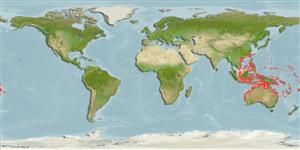>
Eupercaria/misc (Various families in series Eupercaria) >
Labridae (Wrasses) > Cheilininae
Etymology: Pteragogus: Greek, pteron = wing, fin + Greek, ago = to drive (Ref. 45335).
More on author: Bleeker.
Environment: milieu / climate zone / depth range / distribution range
Ecologia
marino associati a barriera corallina; distribuzione batimetrica 2 - 64 m (Ref. 86942). Tropical; 26°N - 25°S, 108°E - 173°W
Western Pacific: Indonesia to the Coral Sea, north to Guam, south to southeastern Australia. Recently recorded from Tonga (Ref. 53797).
Size / Peso / Age
Maturity: Lm ? range ? - ? cm
Max length : 15.0 cm TL maschio/sesso non determinato; (Ref. 9002)
Spine dorsali (totale): 9; Raggi dorsali molli (totale): 11; Spine anali 3; Raggi anali molli: 9. It can be distinguished from the other species by its longitudinal lines along the body (Ref. 48636). Differs from P. cryptus and P. guttatus by having IX, 11 rather than X, 9-10 dorsal rays and males with filamentous extensions on first two rather than the first four interspinous dorsal membranes (Ref. 37816).
Found in various habitats from shallow algae reefs to deep offshore on soft bottom with sponges and hydroid colonies (Ref. 9002). Mostly small, secretive species, usually hiding among dense weeds (Ref. 9002). It rarely leaves its cover except to move quickly between hydrozoan colonies, but not before having a good look around first to make sure its safe (Ref. 48636).
Life cycle and mating behavior
Maturità | Riproduzione | Deposizione | Uova | Fecundity | Larve
Oviparous, distinct pairing during breeding (Ref. 205).
Kuiter, R.H., 1993. Coastal fishes of south-eastern Australia. University of Hawaii Press. Honolulu, Hawaii. 437 p. (Ref. 9002)
IUCN Red List Status (Ref. 130435)
Threat to humans
Harmless
Human uses
Informazioni ulteriori
BibliografiaAcquacolturaProfilo di acquacolturaVarietàGeneticaElectrophoresesEreditarietàMalattieElaborazioneNutrientsMass conversion
CollaboratoriImmaginiStamps, Coins Misc.SuoniCiguateraVelocitàModalità di nuotoArea branchialeOtolithsCervelliVista
Strumenti
Special reports
Download XML
Fonti Internet
Estimates based on models
Preferred temperature (Ref.
123201): 25.2 - 29.3, mean 28.4 °C (based on 1669 cells).
Phylogenetic diversity index (Ref.
82804): PD
50 = 0.5010 [Uniqueness, from 0.5 = low to 2.0 = high].
Bayesian length-weight: a=0.01585 (0.00707 - 0.03555), b=2.95 (2.76 - 3.14), in cm total length, based on LWR estimates for this (Sub)family-body shape (Ref.
93245).
Trophic level (Ref.
69278): 3.5 ±0.4 se; based on size and trophs of closest relatives
Resilienza (Ref.
120179): Alto, tempo minimo di raddoppiamento della popolazione meno di 15 mesi (Preliminary K or Fecundity.).
Fishing Vulnerability (Ref.
59153): Low vulnerability (10 of 100).
Nutrients (Ref.
124155): Calcium = 82.1 [49.7, 139.3] mg/100g; Iron = 0.716 [0.423, 1.308] mg/100g; Protein = 18.4 [15.6, 20.6] %; Omega3 = 0.171 [0.110, 0.266] g/100g; Selenium = 27.4 [16.4, 48.2] μg/100g; VitaminA = 143 [44, 532] μg/100g; Zinc = 1.66 [1.14, 2.57] mg/100g (wet weight);
